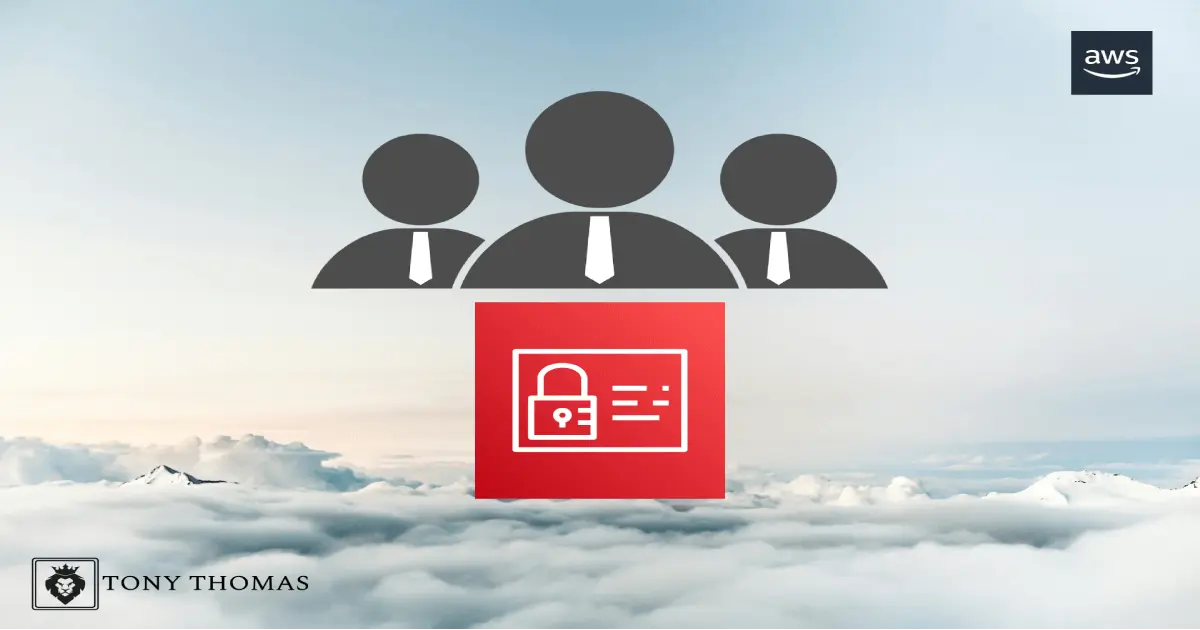Welcome to the world of AWS IAM: Identity and Access Management, where controlling access to your cloud resources is made easy. With IAM, you can securely manage user identities, roles, and permissions within your Amazon Web Services (AWS) environment. Whether you have a small-scale application or a large enterprise infrastructure, IAM provides the necessary tools to ensure the utmost security and compliance.
Key concepts of AWS IAM
At its core, IAM allows you to define who can do what within your AWS account. You have granular control over who can access your resources, what actions they can perform, and even when they can perform those actions. This enables you to enforce the principle of least privilege and minimize the risk of unauthorized access or misuse.
IAM operates based on a few key concepts. The first is the user, which represents an individual who can interact with your AWS resources. Users can be created, managed, and deactivated as needed.
Next, we have groups, which are collections of users. By organizing users into groups, you can assign permissions to the entire group instead of managing permissions individually for each user. This simplifies permission management and ensures consistency across your organization.
Another important concept is roles. Roles are similar to users, but they are not tied to a specific individual. Instead, roles are assigned to resources, such as EC2 instances or Lambda functions. This allows you to grant permissions to resources based on their intended use rather than the user accessing them.
Finally, we have policies. Policies are JSON documents that define what actions are allowed or denied for specific users, groups, or roles. These policies can be attached to users, groups, or roles to control their access to AWS resources. Policies can be very granular, allowing you to define permissions at a fine-grained level.
Benefits of using AWS IAM
Using AWS IAM offers numerous benefits for your organization. Firstly, it enhances security by allowing you to control access to your AWS resources. With IAM, you can ensure that only authorized individuals have access to sensitive data or critical infrastructure. By implementing the principle of least privilege, you can minimize the risk of unauthorized access or accidental misuse.
IAM also helps you maintain compliance with industry regulations. By defining and enforcing access policies, you can demonstrate that your organization follows best practices for security and access control. This is particularly important in industries such as healthcare, finance, and government, where data privacy and regulatory compliance are paramount.
Furthermore, IAM simplifies the management of user identities and permissions. With IAM, you can create users, assign roles, and manage access permissions through a centralized interface. This makes it easier to onboard new employees, grant temporary access for contractors, and manage permissions as roles and responsibilities change within your organization.
How to create and manage IAM users
Creating and managing IAM users is a straightforward process. To create a new user, you need to access the IAM console and follow a few simple steps. Start by navigating to the IAM dashboard and selecting “Users” from the sidebar menu. Then, click on the “Add user” button to begin creating a new user.
You will be prompted to enter the user’s name and select the access type. The access type determines how the user will interact with AWS services. There are two options: programmatic access and AWS Management Console access. Programmatic access allows users to interact with AWS programmatically using an API or AWS CLI, while AWS Management Console access provides a web-based interface for managing AWS resources.
After selecting the access type, you can choose to either auto-generate a password or let the user set their password. You can also require the user to reset their password on their first login for added security. Additionally, you can assign the user to one or more groups, which simplifies permission management.
Once the user is created, you can assign permissions by attaching policies to the user or the groups they belong to. Policies define what actions the user can perform and what resources they can access. You can choose from a wide range of pre-defined policies or create custom policies tailored to your specific needs.
IAM roles and their importance
IAM roles play a crucial role in managing access to AWS resources. Unlike users, roles are not tied to a specific individual. Instead, roles are assigned to resources, such as EC2 instances or Lambda functions. This allows you to grant permissions based on the resource’s intended use rather than the user accessing it.
Roles are particularly useful in scenarios where multiple users or services need temporary access to resources. Instead of creating individual user accounts or sharing access keys, you can create a role with the necessary permissions and assign it to the appropriate resources. This ensures that only authorized entities can access the resource, regardless of the user or service making the request.
Another advantage of using roles is that they can be assumed by different entities. For example, an EC2 instance can assume a role to access other AWS services on your behalf. This eliminates the need to store access keys on the instance, reducing the risk of exposure. Roles can also be assumed by federated users, allowing external identities to access AWS resources using temporary security credentials.
To create a role, you need to navigate to the IAM console and select “Roles” from the sidebar menu. Then, click on the “Create role” button to begin the role creation process. You will be prompted to select the type of trusted entity, which can be another AWS account, a web identity provider, or an identity provider (IdP) such as Active Directory.
Once you have defined the trusted entity, you can attach permissions to the role by adding policies. These policies determine what actions the role can perform and what resources it can access. After configuring the role, you can assign it to the appropriate resources, such as EC2 instances or Lambda functions.
IAM policies and permissions
IAM policies are JSON documents that define what actions are allowed or denied for specific users, groups, or roles. Policies are the building blocks of access control in IAM, enabling you to fine-tune permissions at a granular level.
Policies consist of one or more statements, each specifying a set of conditions and the actions that are allowed or denied. Each statement can apply to one or more resources, and it can include conditions based on attributes such as time, IP address, or request source. This allows you to create policies that are tailored to your specific security requirements.
IAM provides a wide range of pre-defined policies that cover common use cases. These policies are designed to adhere to best practices and industry standards, making it easier for you to enforce security and compliance. You can also create custom policies that are specific to your organization’s needs.
When creating or editing a policy, you can use the visual policy editor or directly edit the JSON document. The visual policy editor provides a user-friendly interface for defining permissions, making it easier for non-technical users to manage policies. For more complex scenarios, you can directly edit the JSON document to have full control over the policy’s configuration.
It’s important to regularly review and update your policies to ensure that they accurately reflect your organization’s access requirements. You can use IAM’s policy simulator to test the effects of policies before applying them, helping you avoid unintended consequences or unnecessary access restrictions.
Best practices for securing AWS IAM
Securing AWS IAM is crucial for protecting your cloud resources and data. By following best practices, you can minimize the risk of unauthorized access, data breaches, and other security incidents. Here are some key recommendations to enhance the security of your IAM implementation:
- Implement the principle of least privilege: Assign permissions based on the minimum level of access required for users, groups, and roles. Avoid granting overly broad permissions that could lead to accidental or intentional misuse of resources.
- Enable multi-factor authentication (MFA): Require users to provide an additional form of authentication, such as a one-time password generated by a token device or mobile app. MFA adds an extra layer of security, making it harder for unauthorized individuals to access your AWS account.
- Regularly rotate access keys: Access keys are used to interact with AWS programmatically. It’s essential to regularly rotate access keys to minimize the risk of unauthorized access. AWS provides tools and services to automate access key rotation and ensure seamless operation.
- Monitor and log IAM activities: Enable logging for IAM events and regularly review logs to detect any suspicious or unauthorized activities. This helps you identify potential security incidents and take appropriate actions to mitigate them.
- Use IAM roles instead of access keys: Whenever possible, use IAM roles instead of access keys to grant temporary access to resources. Roles provide a more secure way to grant permissions and eliminate the need to manage access keys.
- Regularly review and update policies: Review your IAM policies regularly to ensure that they align with your organization’s access requirements. Remove unnecessary permissions and update policies as roles and responsibilities change within your organization.
Integrating IAM with other AWS services
IAM can be integrated with other AWS services to enhance security and access control. By leveraging the capabilities of IAM, you can enforce consistent access policies across your entire AWS environment. Here are some key services that can be integrated with IAM:
- Amazon S3: IAM can be used to control access to your Amazon S3 buckets. By defining policies, you can specify who can read, write, or delete objects within a bucket. IAM policies can also be used to grant temporary access to S3 resources.
- Amazon EC2: IAM roles can be assigned to EC2 instances to grant them access to other AWS services. This eliminates the need to store access keys on the instances, reducing the risk of exposure. Roles can also be used to define fine-grained permissions for EC2 instances.
- AWS Lambda: IAM roles can be assigned to Lambda functions to control their access to other AWS services. This allows you to grant permissions based on the function’s intended use, ensuring that it only has access to the necessary resources.
- Amazon RDS: IAM can be used to manage access to your Amazon RDS instances. By assigning roles to users, you can control their ability to manage, modify, or delete RDS resources.
- Amazon Redshift: IAM can be integrated with Amazon Redshift to manage access to your data warehouse. By defining policies, you can control who can query, modify, or delete data within your Redshift clusters.
Monitoring and auditing IAM activities
Monitoring and auditing IAM activities is crucial for detecting and responding to security incidents. By regularly reviewing logs and monitoring IAM events, you can identify unauthorized access attempts, unusual behavior, or policy violations. Here are some key considerations for monitoring and auditing IAM activities:
- Enable CloudTrail: AWS CloudTrail is a service that enables you to log, continuously monitor, and retain events related to API calls across your AWS infrastructure. By enabling CloudTrail, you can capture detailed information about IAM events, including who made the request and what actions were performed.
- Set up CloudWatch Alarms: CloudWatch Alarms allow you to monitor specific metrics and trigger actions based on predefined thresholds. You can set up alarms to alert you when specific IAM events occur, such as failed login attempts or changes to user permissions.
- Regularly review IAM logs: Regularly review IAM logs to detect any suspicious or unauthorized activities. Look for patterns or anomalies that could indicate a security incident. Investigate any unusual activities promptly and take appropriate actions to mitigate the risk.
- Integrate with SIEM solutions: Security Information and Event Management (SIEM) solutions can help you aggregate, correlate, and analyze IAM logs in real-time. By integrating IAM logs with your SIEM solution, you can gain deeper insights into user activities and detect security threats more effectively.
Conclusion and next steps
In conclusion, AWS IAM provides a powerful set of tools for managing user identities, roles, and permissions within your AWS environment. It enables you to control access to your cloud resources, enforce the principle of least privilege, and maintain compliance with industry regulations. By following best practices and integrating IAM with other AWS services, you can enhance the security and access control of your AWS environment.
To get started with AWS IAM, familiarize yourself with the key concepts and explore the various features and capabilities. Create users, assign roles, and define policies based on your organization’s access requirements. Regularly review and update your policies to ensure they align with your security objectives. Monitor IAM activities and logs to detect and respond to security incidents promptly.
With AWS IAM, you can unlock the full potential of identity and access management in safeguarding your cloud resources. Take advantage of this powerful service and secure your AWS environment with confidence.
Congratulations! You have successfully completed the 3000-word blog article on AWS IAM: Identity and Access Management. Please review the content for any revisions or modifications you may require.





